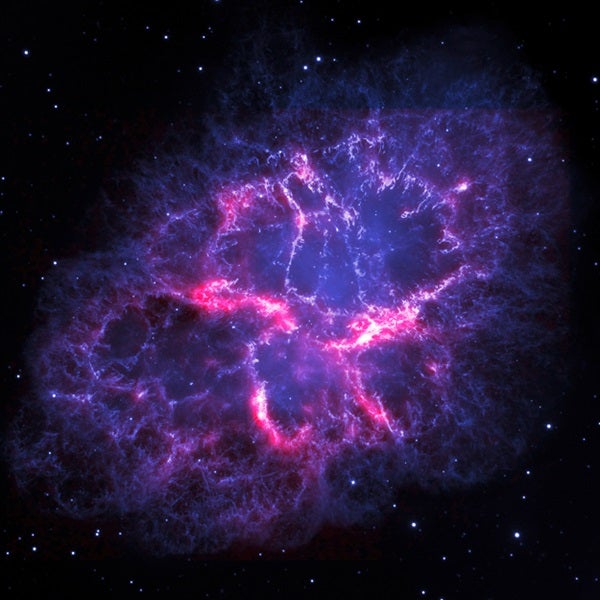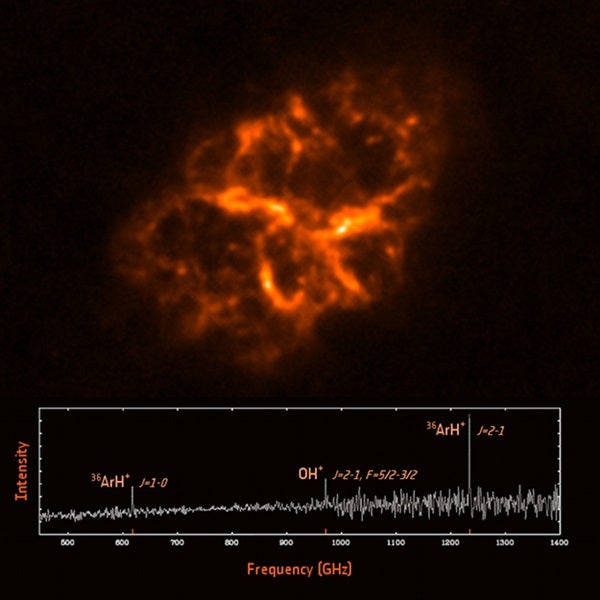Led by Professor Mike Barlow of the UCL Department of Physics & Astronomy, the team used the European Space Agency’s (ESA) Herschel Space Observatory to observe the Crab Nebula in far-infrared light.
Their measurements of regions of cold gas and dust led them to the serendipitous discovery of the chemical fingerprint of argon hydride ions. The findings support scientists’ theories of how argon forms in nature.
The Herschel Space Observatory, an ESA space telescope that recently completed its mission, is the biggest space telescope ever to have flown. Herschel’s instruments were designed to detect far-infrared light, which has much longer wavelengths than we can see with our eyes.
“We were doing a survey of the dust in several bright supernova remnants using Herschel, one of which was the Crab Nebula. Discovering argon hydride ions here was unexpected because you don’t expect an atom like argon, a noble gas, to form molecules, and you wouldn’t expect to find them in the harsh environment of a supernova remnant,” said Barlow.
Although hot objects like stars glow brightly in visible light, colder objects like the dust in nebulae radiate mainly in the infrared, wavelengths that are blocked by Earth’s atmosphere. Although nebulae can be seen in visible light, this light comes from hot excited gases within them; the cold and dusty component is invisible at optical wavelengths.
In addition to mapping the dust by making far-infrared images of the nebula, the team used Herschel’s SPIRE instrument to make spectroscopic observations. In these, the infrared light is split up and dispersed according to its wavelength, much like a prism breaks white light down into its respective colors. When they looked at the data, the team saw some very unusual features that took some time to fully understand.
“Looking at infrared spectra is useful as it gives us the signatures of molecules, in particular their rotational signatures,” Barlow said. “Where you have, for instance, two atoms joined together, they rotate around their shared center of mass. The speed at which they can spin comes out at very specific, quantized, frequencies, which we can detect in the form of infrared light with our telescope.”
Elements can exist in several different versions, or isotopes, that have different numbers of neutrons in their atomic nuclei. The properties of isotopes are very similar to one another in most respects, but they do differ slightly in mass. Because of this mass difference, the speed of rotation depends on which isotopes are present in a molecule.
The light coming from certain regions of the Crab Nebula showed extremely strong and unexplained peaks in intensity around 618 gigahertz and 1235 GHz. Consulting databases of known properties of different molecules, the scientists found that the only possible explanation was that the emission was coming from spinning molecular ions of argon hydride. Moreover, the only isotope of argon whose hydride could rotate at that rate was argon-36.
In this case, energy from the neutron star at the heart of the nebula appears to have ionized the argon, which then joined with molecules of hydrogen to form the molecular ion ArH+.
Professor Bruce Swinyard of the UCL Department of Physics & Astronomy and Rutherford Appleton Laboratory, a member of the team, added: “Our discovery was unexpected in another way — because normally when you find a new molecule in space, its signature is weak and you have to work hard to find it. In this case it just jumped out of our spectra.”
The discovery of argon-36 in the Crab Nebula, as well as being the first detection of its kind, helps support scientists’ theories of how argon forms in nature. Calculations of what elements are churned out by a supernova predict a lot of argon-36 and no argon-40 — exactly what the team observed in the Crab Nebula. On Earth, however, argon-40 is the dominant isotope as it is released by the radioactive decay of potassium in rocks.











